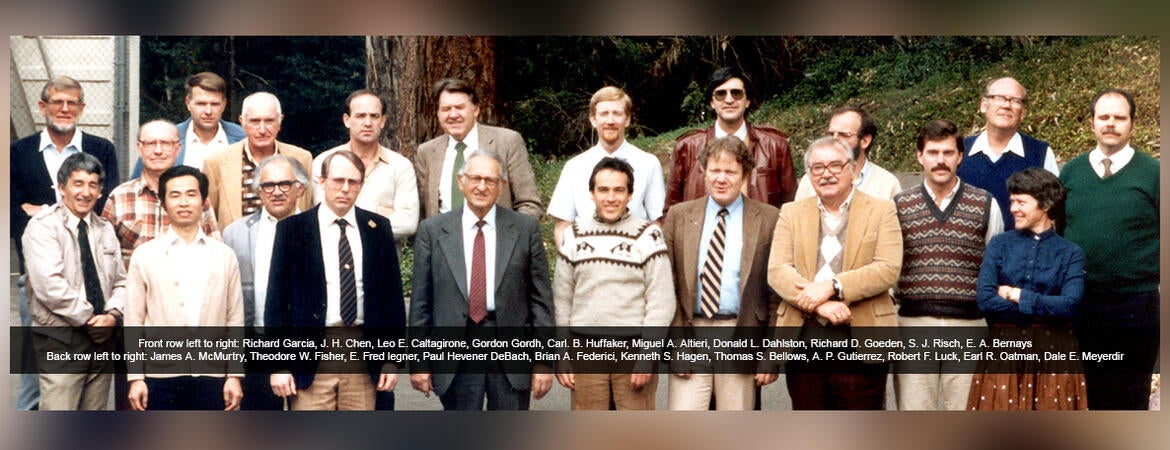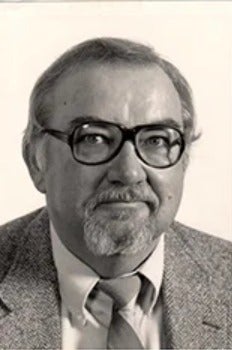
Richard Dean “Dick” Goeden, Professor Emeritus of Entomology, passed away on August 17, 2023.
Goeden was born in Neillsville, Wisconsin on May 20, 1935, to Aleda and InJerome Goeden. He grew up in Wisconsin, but little is known about his childhood; he did at times recall that he played cards after school with his buddies “Augie” Busch and “Freddie” Miller of the local beer brewing families. Following high school, he enlisted in the US Air Force during the Korean War. He was stationed on the Channel Islands off the coast of California working in a communications tower where he scanned the skies for enemy aircraft and at one point tracked Soviet MiGs flying along the coast. He was honorably discharged but often stated his duration in the military as “3 years, 7 months and 23 days” to clearly indicate he counted down the days until he was out. Due to lack of any parental support, he used the GI Bill to further his education. He matriculated to the University of Wisconsin-Madison in 1958 and graduated with a BS in 1962, the same year he wed Joan Apazeller with whom he remained married for 60 years until her passing in 2022.
We do not know what sparked Goeden’s initial interest in entomology, but he continued at UW-Madison working with famed forest entomologist Dale M. Norris, Jr. for a MS (1963) and Ph.D. (1965) in entomology. His master’s thesis was titled “Preliminary findings on the bionomics of Scolytus quadrispinosus Say (Coleoptera: Scolytidae).” He continued this research for his Ph.D. which culminated in the publication: “Some Biological and Ecological Aspects of Ovipositional Attack in Carya spp. by Scolytus quadrispinosus (Coleoptera: Scolytidae)” in the Annals of the Entomological Society of America, 1965, 58 (6): 771–777. It stated that his graduate work was funded by the National Science Foundation and the Wisconsin Conservation Department.
It also is unclear why Goeden became interested in biological control of weeds, but Norris’ influence may have had an effect. Norris conducted research pre-dating the publication of Rachel Carson’s Silent Spring showing that DDT was largely ineffective against bark beetles and should be avoided in fighting Dutch Elm disease. As Goeden was finishing his Ph.D. work in 1965 a position became available in the Department of Biological Control, University of California, Riverside for a biological control of weeds specialist, to which he applied; it must have appealed because it combined his love of both insects and plants. He often told the story that the department head, Glen Carman, invited him out for an interview in the springtime when the hills surrounding Riverside were green from the winter rains. He was offered and accepted the position and upon his return to start his new job in June of 1965, he and Joan were dismayed to see the hills and the sky had turned to their annual summertime brown hue. In spite of the unexpected seasonal changes, they remained in Riverside for the remainder of their lives.
Goeden became a luminary in the field of biological control of weeds; a subdiscipline that primarily uses insect herbivores as a means to attain widespread control of plants that damage natural and agricultural systems. In an ironic twist, one of his first assignments at UC Riverside was documenting the previous 25 year’s efforts of the Opuntia cactus biological control program on Santa Cruz Island, the same place where he had perched years before in a military tower looking for enemy planes. The Optunia project was started by Professor Harry Scott Smith, Department of Biological Control, UC Riverside, in 1940 and was the first use of a live organism to control a weed in North America. In 1967, Goeden, along with Charles A. Fleschner, Professor and Entomologist, and Donald W. Ricker, Staff Research Associate, published an exhaustive, and often cited, treatise on the program’s status which became one of only three targeted weed species in California’s history to achieve complete biological control.
The scientists who developed and implemented biological control of weeds programs were extremely disciplined and principled. They were a tight knit, strict, and self-policing group because they knew releasing primary herbivores into a new environment came with huge ecological risks and if they were responsible for any mistakes, it could spell the end of the use of biological control for pest management across the board. To their credit, biological control of weeds has avoided such disasters and remains a viable management approach to this day.
Goeden’s specialty was faunistic surveys for insects associated with indigenous and non-indigenous weeds, an interest he developed in college where he participated in floristic surveys and contributed beautifully preserved specimens to the university’s herbarium. His career surveys took him to many parts of the world and on extended sabbaticals with his growing family to Italy, Switzerland, France, and England beginning in 1970. He conducted biological control research on every continent except Antarctica. These studies formed the basis for the eventual movement and establishment of weed feeding biological control agents to restore ecological balance to disrupted ecosystems in the US and abroad. Goeden oversaw the importation and establishment of a weevil, Rhinocyllus conicus, into California for the biological control of the invasive weeds Italian and milk thistles. His work on this project clarified a crucial element in the overall success of biological control agents relating to their area of origin. He established that phytophagous species that occur over a wide latitudinal range develop distinct climate biotypes; and these biotypes need to be carefully matched to the climate of their eventual area of release in order to maintain the seasonal host plant/herbivore synchrony needed for successful insect reproduction.
Conducting ecological studies after biological control agents have been released is rare due to inevitable funding shortages. However, Goeden made additional significant contributions to the discipline of biological control by managing to conduct crucial post-release evaluations on the outcome of major weed control projects in the US. Through extensive, years-long studies he was able to discern the biotic and abiotic factors that led to the failure of several biological control agents, thus helping to inform future programs.
During his surveys on US ragweeds (Ambrosia spp.) in the mid-1970s he became fascinated with fruit flies in the family Tephritidae, particularly the non-frugivorous species in the subfamily Tephritinae. He published his first dedicated works on these flies in the mid-1980s and redirected his career to focus on their study in southern California from that point forward. Over the next two decades he, along with his technicians and students, published 108 peer-reviewed papers detailing the biology, ecology, and behaviors of 66 of the 149 species of tephritid fruit flies in California. His body of work is considered by colleagues to be among the most extensive and thorough for any native tephritid fauna in the world. His expertise in California’s tephritids was called upon when one of their exotic cousins, the Mediterranean fruit fly, made headlines by invading southern California in the late 1980s, sparking significant public unrest with the use of helicopters applying malathion-laced bait over Los Angeles. He was able to help regulatory researchers clarify the differences between the native species and the invading, fruit-feeding species, for future development of fly control options. His work on tephritids diversified beyond biology and ecology into taxonomy in later years. He always stated the flies were better plant taxonomists than people and relied on his thorough collection records of host plant associations to help him tease apart species concepts. He named new species for his family members and associates and eventually was in turn honored by having a genus named after him, Goedenia.
Goeden was an experiment station scientist to the core. Although, research was his primary focus, his faculty duties also included teaching field entomology and biological control. During his career, federal and state funds supporting experiment stations was eroding fast. Many faculty were forced to seek research money through external grant opportunities. Goeden did not take that route and continued conducting his research program solely on the dwindling government resources, achieving what one colleague stated as getting more peer-reviewed publications per research dollar than anyone else in the department. He averaged over 5 publications per year for 20 years just on fruit flies alone. And his publications were of the highest quality as he was a skilled scientific writer and editor. He was observed spending hours debating with colleagues over a single word choice to ensure that the meaning of a statement couldn’t be misinterpreted.
Goeden retired in 2002 as the last titled “Professor of Biological Control” at UC Riverside shortly after receiving a lifetime achievement award for research excellence at the Entomological Society of America’s annual meeting in Montreal in 2000. Dick was a dedicated scientist and loved his work immensely. He donated his massive collection of curated tephritids to the US National Museum, UC Riverside and Cal Poly, San Luis Obispo. He had developed an encyclopedic and intimate knowledge of California’s ecology and ecosystems after years of combing through its backroads; knowledge he willingly shared with colleagues that ultimately led to their own discoveries. He thoroughly enjoyed mentoring graduate students to whom he was incredibly generous with his time and advice. He provided them many life and career lessons as he was always available for a friendly chat over coffee or deeper conversations where he patiently listened and offered meaningful, non-judgmental feedback. He instilled students with a strong scientific ethic. His mantra was – always stand on the science you’ve done and do not speculate too far beyond that. And don’t procrastinate!
More importantly, Dick Goeden was a loving and dedicated family man. He and Joan raised three children, who he was so proud of, and delighted in the time they had with their four grandchildren and two great-grandchildren. He also was an accomplished gardener and avid painter creating a multitude of incredibly photo-realistic scenes from his many travels around the world. He maintained a collection of beer steins throughout his life, perhaps a nod to his card-playing pals from his youth, and always enjoyed sharing a beer with friends and family, especially around a backyard barbeque. He was a self-made man who made an indelible impact on the science of biological control, tephritid biology, and the many students he mentored through the years.
David Headrick, Professor, Department of Plant Sciences, Cal Poly San Luis Obispo
Richard Redak, Professor, Department of Entomology, UC Riverside
